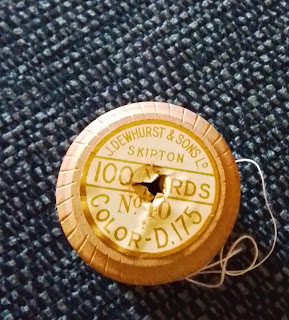A Visit to Masson Mills
If you take a trip down the A6 south from Matlock, you can’t fail to miss Masson Mills. Built by Sir Richard Arkwright ‘s company in 1783, the cotton mill was deliberately constructed to stand out. Back then, the majority of Derbyshire buildings were constructed of local stone. Arkwright chose red brick for his new mill – a big sore thumb next to the Derwent. It showed off just how rich he had become on the proceeds of his cotton spinning. There is a ring attached to one of the internal walls which is reputedly where Arkwright tied his horse when he came to inspect the works. They say that if you touch it, you will become as rich as he was!
Today, the mill buildings are a museum and heritage centre, and guided tours currently take place on Thursdays and Fridays. I decided to join one of these, as I thought it could be a source of ESCC information. Masson Mills became part of the ESCC combine when the grouping took place in 1897, and remained operational until 1991.
I was very pleased to be greeted by 2 relics of the company as soon as I entered the building. The doormat shown below was the first thing I saw, and next to the doors are the staff long service boards, listing the names of those who gave their working lives to the ESCC. I saw a very similar board in the Craven Museum, that had come from the ESCC mill in Skipton (home of Sylko).
Before the tour began, we were shown a short film of an actor playing Sir Richard Arkwright, which gave us the context of the mill buildings. We were then invited to clock in to our tour, and led to the old main entrance of the mills. This is where all the staff would have entered to begin their 12 hour shift after being summoned by a bell that could be heard from 3 miles away.
We were led down to a huge, draughty room full of old machinery related to the cotton industry. First, the weaving frames were demonstrated to us, and our tour guide explained how these functioned. Three machines were switched on so that we could see exactly how they worked – and hear the noise. It was an utter cacophony- and as our guide pointed out, if this was the noise that 3 made, imagine working in a room of 100 machines. On the subject of industrial diseases, the guide explained how loading the shuttles with the cotton thread involved sucking the thread end through a small hole, which led to “Weaver’s Lung” a respiratory disease caused by cotton fibres. No one thought to change the design of the shuttles until the 1950s.
After seeing the finished product being woven into cloth, we moved on to look at how the raw cotton fibre was processed into thread. The first stage was to put it through this evil looking machine to get rid of any impurities.
It was nicknamed “the devil” for good reason – if you got your hair, clothes or limbs caught in it, you’d had it. Accidents would happen, especially towards the end of a 12 hour shift. We then looked at the machines that drew the raw cotton fibre out and twisted it to make it stronger. This is the point at which a lot of children were employed – from 9 years old upwards, small children were taken on to get between the moving machines and pick up any fibres that had fallen through. This too was very dangerous. Often, the overseer would bring in his own children so that he could keep their pay.
It’s a sobering reminder of just how much ordinary working people had to pay to bring comfort to the richer classes. Sir Richard Arkwright unfortunately built his empire on slave cotton pickers along with death, serious injury and child labour in his mills. Those who got limbs caught in machinery and were maimed were simply thrown out of work without compensation or benefits.
Our tour closed with a look at how the mill was powered. Originally, a waterwheel in the Derwent powered the looms – the weir is shown below. There is now a hydro electric scheme powering the museum and earning income for them too. We also looked at the old boiler room and saw a power generator in action.
The tour lasted for an hour and a half. I really learned a lot from it and would recommend it – our guide was so knowledgeable. As an aside, I have heard rumours that the mill is haunted and kept a wary eye out for the supernatural! I was to be disappointed...although I did feel a sudden coldness creep up on me as I watched the weaving....!







Comments
Post a Comment